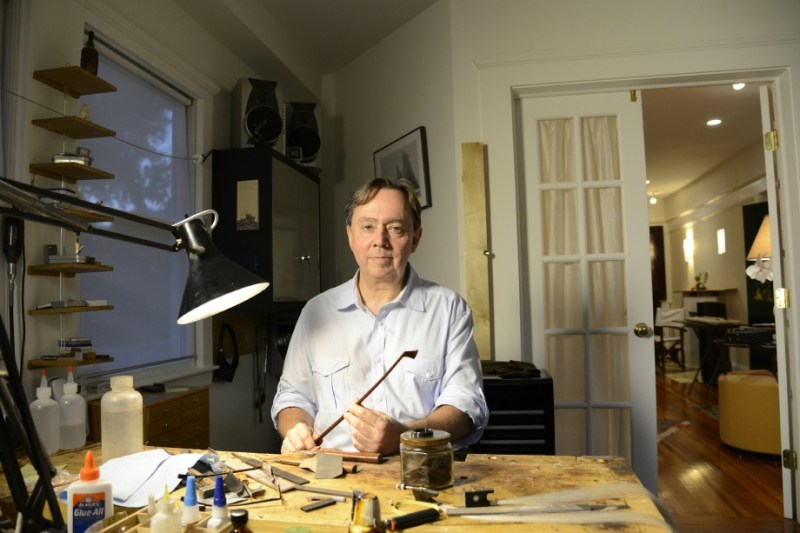
The phone call from the foundation announcing his award was a “total shock,” Rolland admits. While the MacArthur Foundation fellows have always been an eclectic mix, ranging from neuroscientists to novelists, Rolland’s work is a rare mix of science and art. His work involves extensive knowledge of mechanics and physics, but the end result is pure beauty.
Rolland’s bow-making studio is a minimalist’s 120 square foot room, tucked away on a quiet street in Watertown, Massachusetts. Thanks to the MacArthur grant, he will expand the workspace to double its current size. The space’s white walls are brightly lit, with gauges to control the temperature and humidity of where his renowned bows are made. One table is scattered with specialty tools and a variety of glues.
“I’m sorry, it’s a bit of a mess,” Rolland apologizes for the table’s appearance. For someone with a conspicuous genius for music and making instruments (he has invented bows that are used all over the world), he is humble and soft-spoken, a self-proclaimed introvert. Patiently answering questions about the different types of wood that he uses, his process for creating bows, and the countless hours he has spent crafting them, it’s clear that he was meant for this kind of work.
Most of the attention he has received, after all, centers upon his work with violin bows and the MacArthur grant – understandably. But a little time in Rolland’s world reveals that the Parisian-born icon is also a sculptor, photographer, and long-time fan of Edgar Allen Poe. In his living room, a small, lighted display case holds a sculpture that he recently made from a block of Box wood.
Even the two clocks in his studio were hand-crafted by Rolland himself. “I don’t like time,” he admits, which may explain why neither clock has numbers. A wooden one, shaped like a flame once the hands reach twelve o’clock, only gives an idea of time, rather than an exact measurement. The black plexiglass clock is more precise: “The length of the hands changes depending on what minute it is, so you have to know the clock very well in order to know the time,” he explains enthusiastically.
His photographs, like his bows and his sculptures, show a deep-seated love for simplicity. One features a single horse in an open, green field, while another captures a run down shack on Azores, a Portuguese island where many of his photographs were taken. He quickly clarifies that he is not a professional photographer, but that this is something he loves to do.
The MacArthur grant will give Rolland the resources he needs to work on a book he has been hoping to write for many years. The book will chronicle the life of Francois Xavier Tourte, a 19th Century bow maker who, in Rolland’s eyes, was “brilliant” but written about incorrectly during his time. In previous biographies, Tourte was depicted as an illiterate who just so happened to make great bows. Rolland plans to finally write a book that will pay homage to Tourte’s intelligence and character. “I’m not Zorro,” he smirks, “but I think it will do him some justice.”
But even with the book and his other artistic pursuits, Rolland has no plans to stop making his signature bows. His process involves first hearing the musician play, so that he can sculpt a bow to fit their unique personality and musicality. When he started to learn the art at seventeen years old, it was a dying craft – he was one of only two students at the school he attended in France. Now, bow making’s popularity is on the rise, with more musicians and composers than ever.
Rolland talks of one day opening a bow-making school in Boston. But for now, he wants to continue his research with new prototypes. He may soon be strolling the campus at MIT, where a lab would give him the room and materials to delve deeper into new inventions. Rolland has been sculpting bows for over forty years, but in many respects, his work is just beginning.


